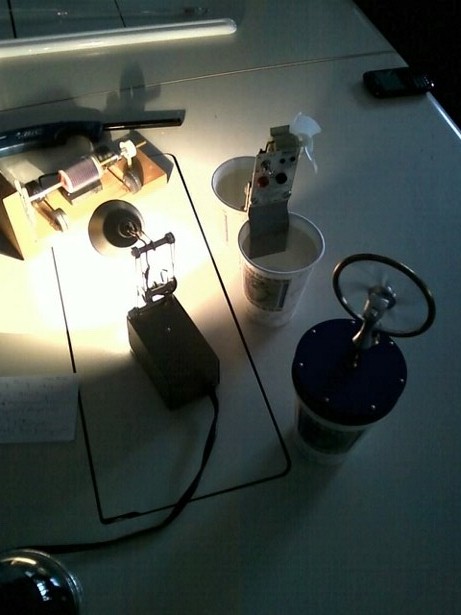Thomas Vales, the Laboratory Coordinator for the Electrical & Computer Engineering Department at Suffolk University’s College of Arts and Sciences, gleefully treated our class to some welcome edutainment about the evolution of electricity.
Mr. Vales began by introducing us to the Peltier Device, which was originally developed in 1834. It functions by using plated copper which is cooled on one side and heated on another to produce electricity. They are used by the military mainly in submarines for silent generation of power. Lighter plugs used to power electronic devices through automobile lighters, as well as containers used in automobiles to keep beverages hot and cold, use this device as well. Mr. Vales finally related that, because they are very inefficient, the Peltier Devices are used relatively sparingly for commercial uses.

The Peltier Device in the two cups and on the spinning wheel. The Mendocino Motor is illuminated by the lamp to receive "solar" power.
Mr. Vales then discussed the solar powered device which is suspended – or levitated – on magnetic bearings and has no practical application, called the Mendocino Motor.
The penultimate discussion traced the history of the Tesla coil, with an introduction to the magnanimous genius who developed it, Nikola Tesla. (Tesla sought no monetary gain for his inventions because he just simply loved his work! As a result, he died penniless.) In 1880, the Polish born Tesla had over 700 U.S. patents, the most popular of which was the method of generating electricity by alternating current (AC). He was backed financially by the entrepreneurial engineer George Westinghouse. Tesla’s AC system was latched on to by Westinghouse to compete with Thomas Edison’s direct current (DC) system. The two geniuses once held a contest to see whose system was more powerful by shocking animals. The animals shocked by Edison’s system lived, whereas Tesla’s system killed the animals, which meant that Tesla’s alternating current was more powerful. It is agreed by experts that alternating current is better and easier to transmit across the country. Westinghouse used Tesla’s alternating current to electrify Niagara Falls, which proved to be “the first large system to supply electricity for multiple uses (railway, lighting, power) from one circuit.” ( http://www.pbs.org/wgbh/theymadeamerica/whomade/westinghouse_lo.html )

